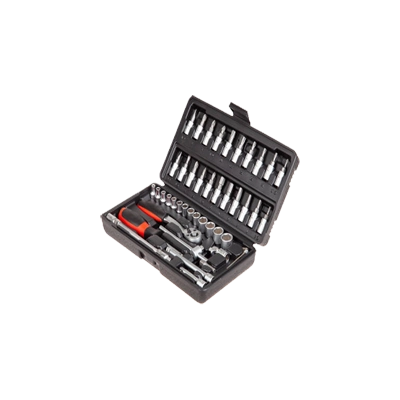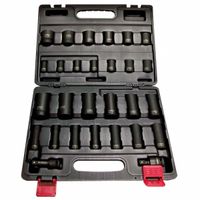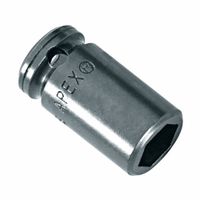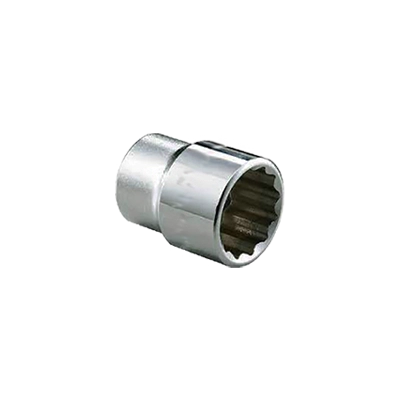Call +(254) 703 030 000 / 751 483 999 / 721 704 777
- Home
- Tools
- Sockets Bits
- Sockets Sets
.....Read More
Frequently Asked Questions
What is the difference between hand sockets and impact sockets?
Hand sockets and impact sockets are both tools used to fasten or loosen nuts and bolts, but they are designed for different applications and have distinct characteristics.
Hand Sockets:
1. **Material**: Typically made from chrome vanadium steel, which provides a smooth finish and resistance to corrosion.
2. **Design**: Designed for use with hand tools like ratchets and wrenches. They have a thinner wall to fit into tighter spaces.
3. **Finish**: Often have a polished or chrome-plated finish for easy cleaning and rust resistance.
4. **Durability**: Not designed to withstand the high torque and vibrations of power tools. Using them with impact tools can lead to cracking or shattering.
5. **Cost**: Generally less expensive due to the materials and manufacturing process.
Impact Sockets:
1. **Material**: Made from chrome molybdenum or other alloys that can withstand high torque and impact forces.
2. **Design**: Thicker walls to handle the stress from impact wrenches and other power tools. This makes them more durable under heavy use.
3. **Finish**: Usually have a black oxide or phosphate finish to prevent corrosion and reduce glare.
4. **Durability**: Specifically designed to absorb the shock and vibrations from impact tools, reducing the risk of breakage.
5. **Cost**: Typically more expensive due to the robust materials and construction.
In summary, hand sockets are ideal for manual applications with lower torque requirements, while impact sockets are essential for high-torque, power tool applications to ensure safety and tool longevity.
How do socket adapters and accessories work?
Socket adapters and accessories are devices that enable compatibility between different types of plugs and sockets, allowing electrical devices to be used in various regions or with different power configurations. They work by providing a physical interface that matches the plug of an electrical device to the socket available in a particular location.
Socket adapters typically consist of a plug that fits into the local socket and a receptacle that accepts the plug of the device. They do not convert voltage or frequency; they merely allow the physical connection. For example, a European plug can be used in a U.S. socket with an adapter that has a European receptacle and a U.S. plug.
Some socket adapters come with additional features, such as USB ports for charging devices, surge protection to guard against voltage spikes, or even built-in voltage converters for devices that require a different voltage than what is supplied by the local power grid.
Accessories like power strips or extension cords expand the number of available outlets, allowing multiple devices to be connected simultaneously. These can also include features like surge protection or individual switches for each outlet.
Universal travel adapters are a type of socket adapter designed to work in multiple countries. They often have interchangeable plugs or a mechanism to adjust the plug configuration, making them versatile for international travel.
In summary, socket adapters and accessories facilitate the use of electrical devices across different regions and configurations by providing the necessary physical connections and sometimes additional functionalities like surge protection or voltage conversion.
What are the benefits of using socket extensions?
Socket extensions offer several benefits:
1. **Increased Reach**: They allow electrical devices to be used at a greater distance from the power source, providing flexibility in the placement of appliances and equipment.
2. **Convenience**: By extending the reach of power outlets, socket extensions reduce the need to rearrange furniture or appliances to access power, enhancing convenience in both residential and commercial settings.
3. **Multiple Outlets**: Many socket extensions come with multiple outlets, enabling the connection of several devices simultaneously, which is particularly useful in areas with limited wall sockets.
4. **Surge Protection**: Some socket extensions include built-in surge protectors, safeguarding connected devices from voltage spikes and electrical surges, thus prolonging their lifespan.
5. **Cost-Effective**: They are a cost-effective solution for expanding power access without the need for additional electrical installations or renovations.
6. **Portability**: Socket extensions are portable and can be easily moved and used in different locations, making them ideal for temporary setups or events.
7. **Safety Features**: Many modern socket extensions come with safety features such as overload protection, child safety shutters, and power switches, reducing the risk of electrical hazards.
8. **Versatility**: They can be used in various environments, including homes, offices, workshops, and outdoor settings, providing power where it is needed most.
9. **Cable Management**: Some socket extensions come with cable management features, helping to organize and reduce clutter from multiple cords and cables.
10. **Adaptability**: They can accommodate different plug types and voltages, making them suitable for international use or in areas with diverse electrical standards.
How do hand socket bits differ from impact socket bits?
Hand socket bits and impact socket bits differ primarily in their design, material composition, and intended use.
Hand socket bits are designed for manual use with hand tools like ratchets and wrenches. They are typically made from chrome vanadium steel, which provides a good balance of strength and corrosion resistance. These bits have a polished or chrome-plated finish, which helps prevent rust and makes them easier to clean. Hand socket bits are not designed to withstand the high torque and vibrations produced by power tools.
Impact socket bits, on the other hand, are specifically designed for use with impact drivers and wrenches. They are made from tougher materials, such as chrome molybdenum steel, which can endure the extreme forces and repetitive impacts generated by these power tools. Impact sockets have a thicker wall and a black oxide or phosphate finish to enhance durability and reduce wear. This finish also helps to absorb the shock and prevent chipping or cracking under high stress.
The key differences lie in their construction and application. Hand socket bits are suitable for lighter, precision tasks where manual control is needed, while impact socket bits are built for heavy-duty applications requiring high torque and impact resistance. Using a hand socket bit with an impact tool can lead to damage or failure of the bit, while using an impact socket bit with a hand tool is generally safe but may be overkill for the task.
What are the advantages of using sockets over open-end wrenches?
Sockets offer several advantages over open-end wrenches:
1. **Efficiency and Speed**: Sockets can be used with ratchet handles, allowing for quicker tightening or loosening of fasteners without needing to reposition the tool after each turn, unlike open-end wrenches which require repositioning.
2. **Versatility**: Socket sets come with various sizes and types, including deep sockets, impact sockets, and specialty sockets, making them suitable for a wide range of applications. They can also be used with different drive tools like ratchets, torque wrenches, and breaker bars.
3. **Better Grip and Torque**: Sockets provide a more secure grip on fasteners, reducing the risk of rounding off bolt heads. They distribute force evenly across the fastener, allowing for higher torque application.
4. **Access to Tight Spaces**: With extensions and universal joints, sockets can reach fasteners in tight or awkward spaces where open-end wrenches might not fit.
5. **Reduced Wear and Tear**: The even distribution of force and better grip reduce wear on both the tool and the fastener, extending their lifespan.
6. **Safety**: The secure fit of a socket reduces the likelihood of slipping off the fastener, minimizing the risk of injury.
7. **Convenience**: Socket sets are compact and organized, making it easy to find the right size quickly, whereas open-end wrenches can be bulkier and harder to organize.
8. **Adaptability**: Sockets can be used with power tools, such as impact drivers, for even faster operation, which is not possible with open-end wrenches.
Overall, sockets provide a more efficient, versatile, and safer option for many mechanical tasks compared to open-end wrenches.
How do you choose the right socket size for a fastener?
To choose the right socket size for a fastener, follow these steps:
1. **Identify Fastener Type**: Determine if the fastener is metric or imperial. Metric fasteners are measured in millimeters, while imperial fasteners are measured in inches.
2. **Measure Fastener Size**: Use a caliper or a ruler to measure the width across the flats of the fastener head. This is the distance between two parallel sides of the fastener.
3. **Match with Socket Set**: Refer to your socket set, which should have both metric and imperial sizes. Match the measurement you obtained with the corresponding socket size. For metric fasteners, use metric sockets; for imperial fasteners, use imperial sockets.
4. **Check Fit**: Place the socket over the fastener. It should fit snugly without excessive play. A loose fit can strip the fastener, while a tight fit may not go on at all.
5. **Use Socket Conversion Chart**: If you only have one type of socket set (metric or imperial), use a conversion chart to find the closest equivalent size. This is not ideal but can work in a pinch.
6. **Consider Fastener Condition**: If the fastener is worn or damaged, it might require a slightly different socket size. In such cases, try a few sizes to find the best fit.
7. **Test with Ratchet**: Attach the socket to a ratchet and test it on the fastener. Ensure it turns smoothly without slipping.
8. **Use Deep or Shallow Sockets**: Choose between deep or shallow sockets based on the fastener's location. Deep sockets are better for recessed fasteners, while shallow sockets are suitable for flush fasteners.
By following these steps, you can accurately select the right socket size for any fastener.
What are the common drive sizes for sockets and how do they affect compatibility?
Common drive sizes for sockets include 1/4-inch, 3/8-inch, 1/2-inch, 3/4-inch, and 1-inch. These sizes refer to the square-shaped opening on the back of the socket that fits onto the drive tool, such as a ratchet or torque wrench.
1. **1/4-inch drive**: Ideal for precision work and smaller fasteners, often used in electronics or small engine repairs. It offers less torque but is perfect for tight spaces.
2. **3/8-inch drive**: A versatile size, suitable for most automotive and household tasks. It balances torque and accessibility, making it a popular choice for general use.
3. **1/2-inch drive**: Commonly used in automotive and heavy-duty applications. It provides more torque, making it suitable for larger fasteners and more demanding tasks.
4. **3/4-inch drive**: Used in industrial settings and for heavy machinery. It delivers high torque for large fasteners, but is less common for everyday use.
5. **1-inch drive**: Primarily used in industrial and construction applications. It handles the largest fasteners and provides maximum torque.
Compatibility is affected by the drive size because the drive tool and socket must match. Using an adapter can allow different drive sizes to work together, but this may affect the torque and stability. Additionally, the drive size influences the range of socket sizes available, with larger drives typically accommodating larger sockets. Selecting the appropriate drive size ensures efficient and safe operation, preventing damage to tools and fasteners.




